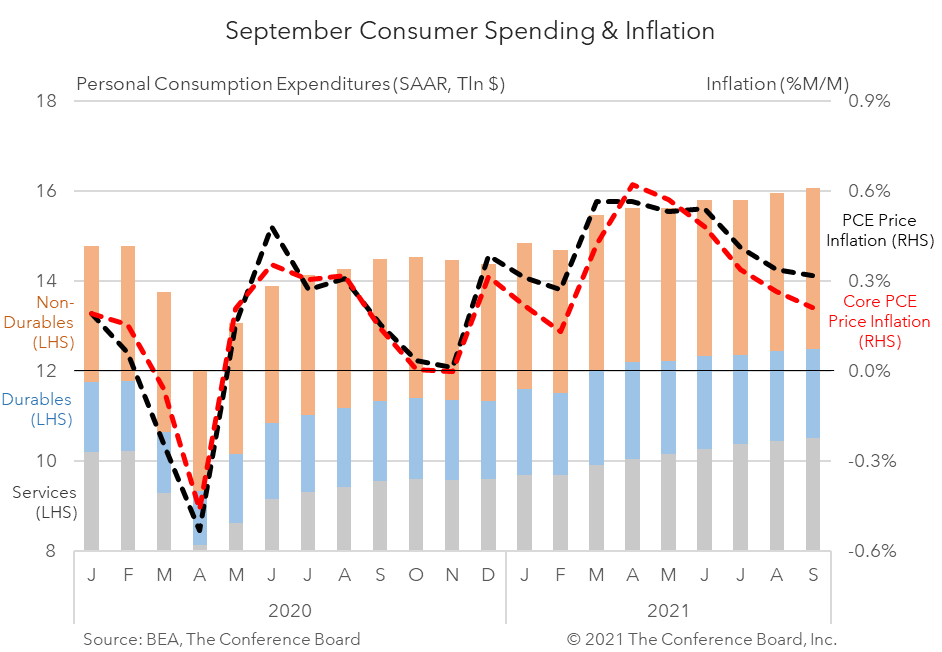September Spending, Income, and Inflation Data Mixed
29 Oct. 2021 | Comments (0)
Comment on Personal Income & Outlays report for September
September Personal Income & Outlays data, released this morning, show an economy emerging from the impact of the Delta variant. According to the Bureau of Economic Analysis (BEA), American incomes fell in September while consumer spending continued to expand. Inflation remained elevated, but the momentum of price increases moderated somewhat.
Looking ahead, as the severity of the current wave of COVID-19 continues to ebb we expect consumer spending growth to accelerate, especially on in-person services. The expiration of some federal unemployment benefits in early September hurt personal income growth for the month, but a tight labor market should help incomes expand once again. While year-over-year (y/y) headline inflation remained at a 30 year high in September the month-over-month readings eased somewhat. Still, inflation readings will remain elevated until wage growth, supply chain disruptions, and excessive demand for some goods ease.
Overall personal income fell 1.0 percent (in nominal terms) month-over-month (m/m) in September largely due to a sharp contraction in personal income transfer receipts associated with the expiration of some federal unemployment benefits. However, income attributed to employee compensation expanded by 0.7 percent – illustrating that working Americans are seeing their incomes continue to expand. This trend in employee compensation is likely to continue as more people rejoin the workforce and wage growth remains strong.
Personal consumption expenditures rose 0.6 percent m/m in September following a 1.0 percent m/m increase in August. Spending on services rose by 0.6 percent m/m while spending on goods rose by 0.5 percent m/m. Meanwhile, spending on durable goods fell by 0.2 percent m/m while spending on non-durable goods rose by 0.9 percent m/m. In real terms, which accounts for inflation, consumer spending grew by 0.3 percent m/m in September with spending on services rising 0.4 percent m/m – a trend that provides positive momentum heading into Q4 2021.
Headline PCE price inflation came in at a 30 year high of 4.4 percent year-over-year (y/y), vs. 4.2 percent y/y in August. The BEA also reported that Core PCE Inflation, excluding food and energy prices, was unchanged from the previous month at 3.6 percent y/y. Importantly, the month-over-month growth rates for these key inflation metrics both eased somewhat. Headline PCE inflation was 0.32 percent m/m in September, vs. 0.34 percent m/m in August and Core PCE inflation was 0.21 percent m/m in September, vs. 0.27 percent m/m in August. The primary inflation drivers in September were associated with food, fuel oil, and housing prices. However, prices gains among some former inflation drivers like new automobiles moderated or, in the case of transportation services, dropped. Excessive demand for some goods along with persistent supply side constraints underpin the current inflation trend.

-
About the Author:Erik Lundh
Erik Lundh is Senior Global Economist for The Conference Board Economy, Strategy & Finance Center, where he focuses on monitoring global economic developments and overseeing the organization&rsquo…




0 Comment Comment Policy